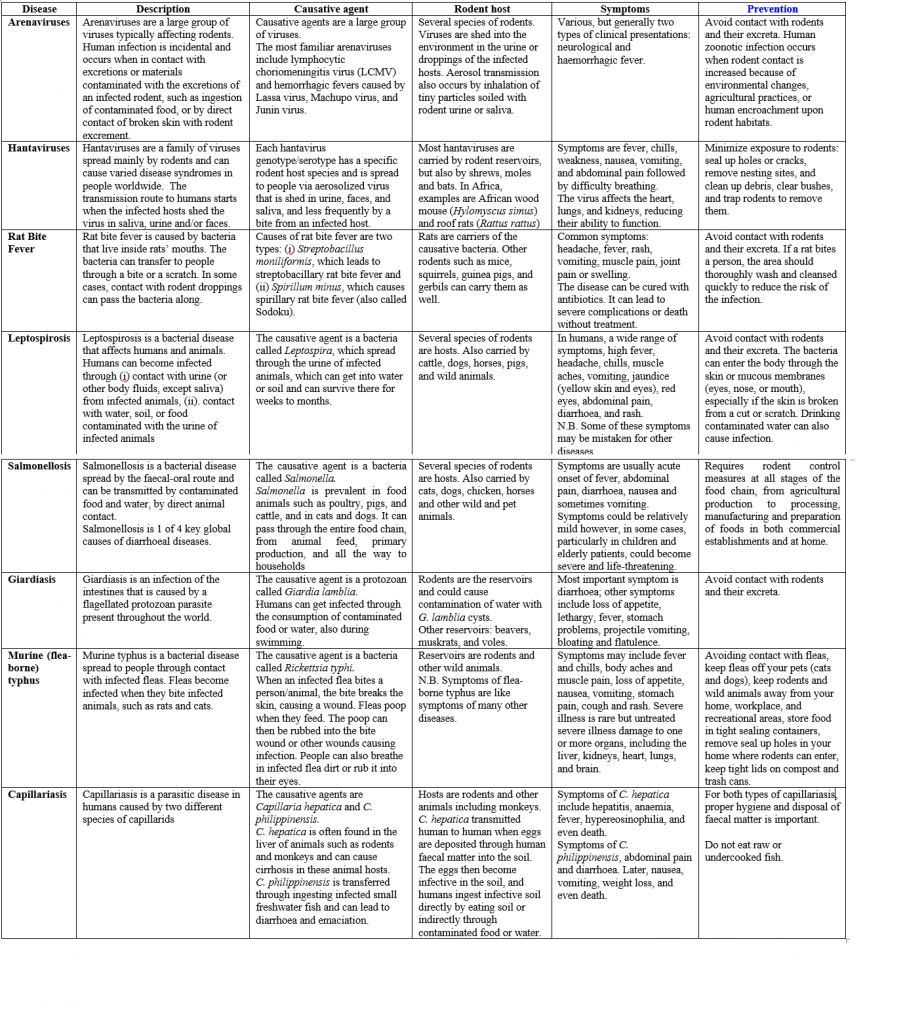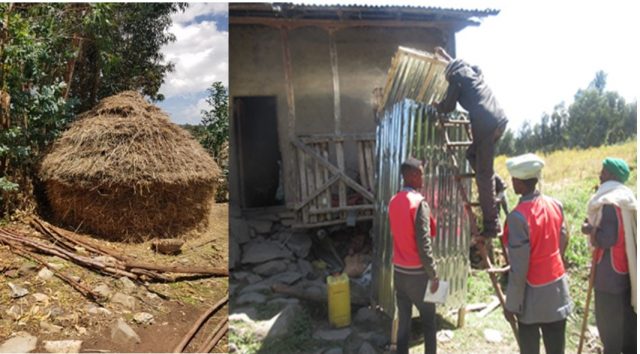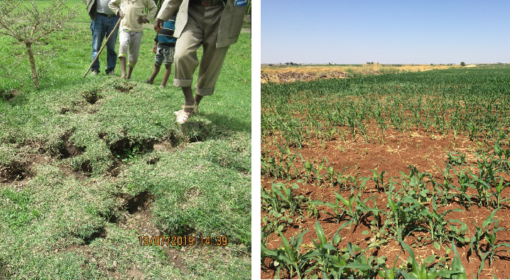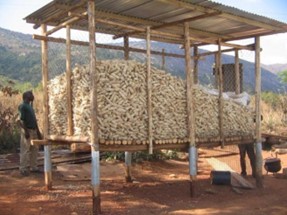By Meheretu Yonas, Luwieke Bosma and Frank van Steenbergen
Village-level Ecologically based Rodent Management is promoted by Rodent Green and MetaMeta Research. Please contact: myonas@metameta.nl
Background
Hygiene is arguably the more forgotten component in WASH. Within WASH, water and sanitation systems have received much attention and there have been important programs to promote hand washing and menstrual health and hygiene, rightly so. But several other dimensions of hygiene do not get the attention they deserve, in particular village pests that carry common diseases which they transmit to humans through direct contact, food contamination or other pathways.
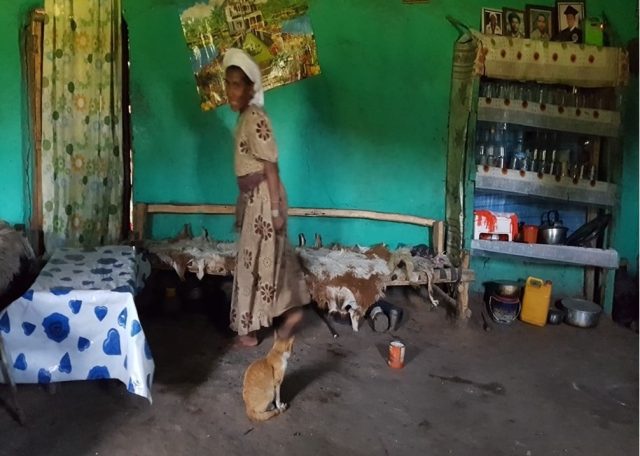
Pest rodents (rats and mice) are important carriers of pathogens that cause diseases in humans and domestic animals. Different rodents have different behaviour and have different propensities to transmit those diseases. Some rodents, like the roof rat (Rattus rattus), prefer to live in the houses and storage areas. Other rodents may prefer the fields.
There are about 60 known diseases transmitted to humans and animals by rodents. Examples of diseases and parasites of public health importance include leptospirosis, salmonellosis, giardiasis, murine typhus (rickettsia), capillariasis and other helminths intermittently shed by rodents. For instance, salmonellosis is the cause of 25% of all diarrhoea cases worldwide. Leptospirosis affects more than one million people annually and cause more deaths than Ebola for instance. Refer ready reckoner table on some of the most common diseases at the end of the text (Table 1).
We advocate that integrating a Village Level Ecologically Based Rodent Management (vEBRM) approach with the activities of Water, Sanitation and Hygiene (WASH) helps improve nutrition, food safety and public health in the villages in Africa and Asia. vEBRM requires awareness and understanding of rodent habits and a change in people’s behaviour, as people often create the ideal conditions for rodents to multiply. Hence, vEBRM does not seek to just exterminate the rodents, but to control their access to food, their habitats, and movements and to make use of natural enemies (Fig. 1). Only in the end selective trapping and killing of rodents may be used to reduce the population. vEBRM discourages the use of chemical rodenticides which are harmful to humans/animals and the environment. vEBRM approaches seek to create a long-term rodent-free environment.
Here are three important aspects:
Aspect 1: Rodents damage and contaminate food. They are a major cause of human diseases through a multitude of transmission pathways and infect livestock as well. They may attack people, especially children and the elderly. They consume food stores, damage property and some rodents will spread bad smells and create annoying noise.
Rodent-associated food and public health issues are arguably one of the most neglected societal problems in the world. Rodents attack crops growing in the field and damage stored grains. Through their urine, body fluids and faeces they contaminate food and stored grains. This has a major impact on food security, nutrition, and food safety.
Rat-bite fever for instance is a zoonotic illness which is manifested by acute relapsing fever with migratory polyarthralgia (a medical condition where pain occurs in several joints of the body) (Table 1). People get rat bite fever if an infected rat or other rodent bites or scratches them. Other rodent carried diseases occur after exposure to the urine or other bodily secretions of an infected rodent. These secretions can be from the mouth, nose, or eyes. Diseases can also be transmitted through food or water that has been contaminated with rat faces or urine.

It is not only humans that are at risk. Also, livestock, especially pigs and cattle, may be affected by rodent transmitted diseases, such as Aujesky’s disease (pseudorabies). Household pets such as dogs or cats exposed to rodents can carry the disease and subsequently infect humans.
Added to the health impacts, rodents are damaging household properties, utensils, clothes, beddings, sewage systems, wires, and houses (doors, windows, roof) (Fig. 2). Rodents damage water storage material such as plastic jerry cans. In rural Ethiopia these are the most common household water storages. Plastic jerry cans are also used to store local drinks such as ‘tej’, ‘areqe’, ‘tela’ and ‘borde’ which in some communities are the main commodities from which particularly women make revenue.
Plastic jerry cans are as well widely used to store grains. Studies indicate that plastic jerry cans are among the most frequently damaged household properties (utensils) by rodents.
Additionally, rodents disturb backyard farming, gnawing on roots and fruits. They cause food supplies to dwindle. If you consider that an average commensal rat consumes 24-35 grams of grain/week and contaminate and waste perhaps 10 times that amount, deterring dozens if not hundreds of them can have a massive positive impact on farm productivity and profitability.
Aspect 2: Inadequate waste disposal, grain and cattle feed storage methods aid the proliferation of rodent populations in villages thereby heightening public health issues
In many rural areas, the standard of household (and village) level sanitation and hygiene is very poor, and many households do not have toilets, pit latrines or waste pits. Because of large family size and small landholdings, backyards are defecating and playing grounds for children. Village level waste disposal systems and communal waste pits are often unavailable and waste disposal, for the most part, is based on household’s discretion, influenced primarily by awareness, size of land and presence of suitable areas. Such neighbourhoods easily attract rodents and are the main sources of gastro-intestinal (faecal-oral) infections, those most at risk being children. Unsanitary rat or mouse droppings, urine, carcasses, and other waste can pose a health hazard to the people living in the area, bringing viral and bacterial diseases that can be passed through contact with faces, urine or spread through food when rodents scavenge in the store or kitchen. It is important to clean up infested areas where people could come in contact with rodent excreta. Rodent droppings have also been linked to an increase in asthma related issues.
People often unwittingly create the ideal living environment for rodents with easy access to food, shelter, and warmth. It is a traditional practice in rural areas to keep domestic animals in the households. Waste from these animals is collected and piled in the backyards for use as a source of energy (fire), organic fertilizer and composting.
Also, a common practice is keeping piles of straw (e.g., from wheat, barley, teff, maize, sorghum harvest in the backyard (Fig. 3) to feed cattle through the dry season. This intricate assemblage of poorly disposed of household and animal wastes, animal feed, composting and gardening practices create a multitude of food and harbourage opportunities for rodent populations to thrive in. In turn, the proliferation of rodent populations in such neighbourhoods (or villages) poses a health risk to humans and domestic animals, given that a rat can have potentially a progeny of 120 a year.
Community interventions, such as vEBRM, improve neighbourhood (village) sanitation and hygiene thereby reduce the proliferation of rodent populations and the spread of rodent-borne infections. Fostering neighbourhood sanitation and hygiene which essentially incorporate practices that deny rodents with food, harbourage and breeding ground is imperative. In a way, enhanced hygiene and sanitation practices obtained through the integration of vEBRM with WASH help to reduce not only chronic undernutrition in children caused by loss of food and grains by rodents and repeated illness caused by conventional diseases such as diarrhoea, but also rampant rodent-borne viruses and bacteria that would affect communities at scale.
Aspect 3: One cannot do this alone: like community WASH, vEBRM needs a systematic collective effort
Every household in the villages needs to understand and actively participate in vEBRM as part of WASH programs. Otherwise, rodent populations and the resulting rodent-associated problems will persist in the villages. Community members need to work together to implement vEBRM and for instance ensure that there are no places where rodents can hide or have access to food.
Because rodent management practices confined to certain households do not bring the required result, rodents have the tendency of moving around houses in search of food and shelter in risk-free (or low risk) neighbourhoods. I.e., when one or two households are hygienic and devoid of rodent food and harbourage, the rodents will temporarily move to non-hygienic households nearby, ideally roaming in the same neighbourhood. If rodent management measures are organised in such a way that the whole village community participates, the house-to-house movement of the rodents will be hindered as they need to move further away in search of food and harbourage in other risk-free (or low risk) areas. Such movements over longer distances in open habitats will inevitably expose rodents to predators. Furthermore, the lack of adequate food and breeding ground limits their ability to multiply and proliferate.
Programmes in WASH that promote and support community/village level hygienic and sanitary practices go in parallel with the principles of vEBRM. Hence, vEBRM could be routinely integrated into WASH activities to further improving the nutrition and public health status of rural communities.
What does Village Level Ecologically Based Rodent Management (vEBRM) look like?
Limited options and knowledge to manage rodents combined with poor housing and storage conditions, and deficient sanitary and hygienic surroundings that provide environments where rodents thrive and continue posing challenges, entail the development of an effective, cooperative, and sustainable rodent management approach. The two key life requirements of rodents are food and shelter.
Therefore, vEBRM strategy should be focused on reducing the availabilities of these two key factors. Furthermore, vEBRM strategies require community participation, political will and
inter-sectorial partnership while considering knowledge and perceptions of the communities affected.
Therefore, the following combined activities composed of awareness, sanitation/hygiene, exclusion and use of traps and baits, could make the main components of village level EBRM. Here are the 10 Key Rules in vEBRM:
- Communities should first appreciate the fact that rodents are a problem for both agriculture and public health, and that it is possible to reduce rodent populations to close to zero.
- Collaborative, community-based participation is imperative at all stages of household and community-level sanitary and hygienic activities and in the introduction of proper storage and house construction to create a healthy village free of rodents. Adequate cleaning, trash removal and rodent-proof trash containers are necessary.
- Establish robust community awareness campaigns to achieve people’s behavioural changes towards rodents, food and grain storage methods and household and community-level waste disposal so that rodents are denied access to food and harbourage.
- Ensure regular inspection of houses, storage areas and gardens. Immediately repair openings where rodents passthrough and take shelter, such as fencing and stone-bunds. When observed, immediately remove any harbourage, rat runways, climbing spots, etc. It is important to understand that rodents are neo-phobic and learn the locations of new objects, food sources and escape routes very quickly.
- Traditional brooming is a special point of attention: especially hard brooms in rodent infested households have the potential to spread rodent-associated RNA viruses and bacteria by contaminated aerosols and arthropod vectors. Hence:
- Ensure minimal dust blows while sweeping using water and soft brooms.
- Use cloth or facemask to cover the mouth and nose.
- Construct storage houses and materials in such a way that it is impossible for rodents to enter ( 3). Ensure that roofs, doors, and windows are fit tightly, and gaps and flaws are avoided. When detected, gaps and flaws should be sealed immediately with rodent-proof material. Interrupters may also be used.

Figure 3 Traditional storage method susceptible for harbouring vermin and rodents (left), and improved rodent-proof storage (right). - Make sure some of the most sensitive household items are protected from rodents:
- Store food, grain, drinking water, household utensils in rodent-proof containers and cabinets to avoid persistent household-level re-infestations.
- Store children/infant food, water and feeding utensils (such as plastic infant/children feeding bottles) in safe containers at all times.
- Encourage keeping domestic cats (and dogs) at household level (see Fig. 1) and discourage chasing and prosecution of natural predators of rodents (such as birds of prey, wild cats, mongoose, snakes).
- If after all these measures rodent infestation persists: use mechanical killing methods (local and commercial traps), flood rodent burrows, and use proven bio–rodenticides (ecologically sustainable rodenticides originated from plant materials) or selected chemical rodenticides to manage rodent populations. Avoid using chemical rodenticides that have no user application information and production and expiry dates.
- Establish and implement strict village (or neighbourhood) bylaws and rules to ensure household and neighbourhood sanitation and hygiene. Use a record-keeping system that lets the community know who are not respecting the bylaws, who are the offenders. Besides, develop and implement community strategy for a solid waste disposal system (including recycling). Additionally, introduce mandatory “one pit waste each, per household and per village” rule in the village bylaws. Organize groups and committees that create awareness about community sanitation and hygiene and are responsible for enforcing the bylaws. Assign responsible bodies for trash removal and maintenance of communal trash containers and trash dumping areas (pits)
Table 1 Examples of rodent-associated diseases and parasites potentially occurring in Ethiopian villages. Brief notes are given about causative agents, rodent hosts, symptoms, and preventions. (Content source: https://www.cdc.gov/, https://www.healthline.com/ and https://www.webmd.com/).
